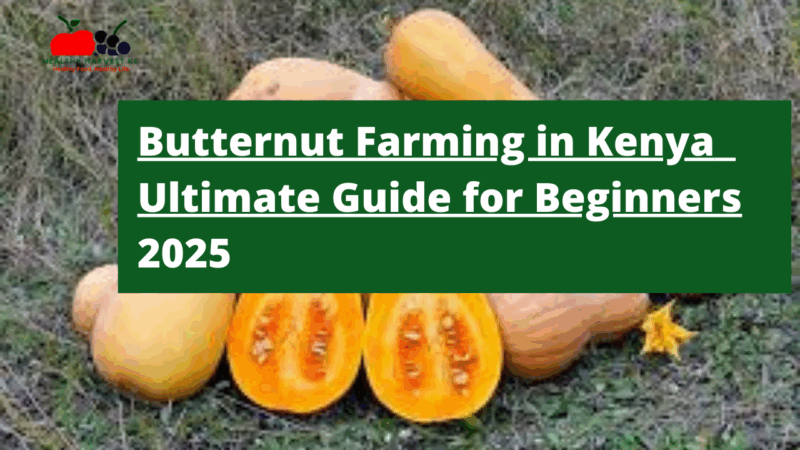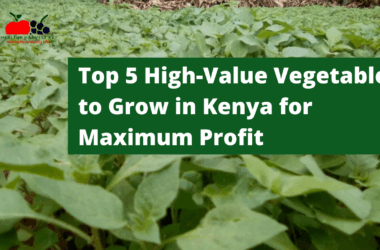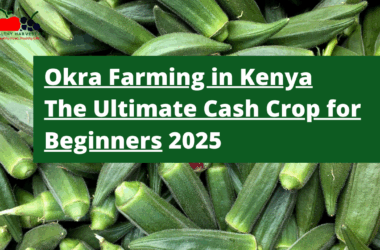Why You Should Consider Butternut Farming
Looking for a crop that won’t break your back but could pad your wallet? Butternut squash farming in Kenya might be your answer. This unique crop has been gaining serious traction lately, and for good reason.
Butternut isn’t just another vegetable—it’s a versatile crop with incredible staying power. While your typical pumpkin might last three months in storage, butternuts can hang around for up to six months. That’s half a year to find the right buyer at the right price!
The golden, pear-shaped fruit stands out in Kenya’s agricultural scene where many farmers are stuck in the maize-beans cycle. With yields of about 6,000 butternuts per acre and each selling for around Ksh30, you’re looking at potential earnings of Ksh180,000 from a single acre. After expenses, that’s roughly Ksh92,100 in profit – not too shabby for a crop that matures in just 90-100 days.
Understanding Butternut Squash
What Makes Butternut Different?
Butternut squash belongs to the Cucurbitaceae family – the same crew that includes pumpkins, zucchinis, and cucumbers. But don’t get it twisted—butternut has its own identity.
These fruits rock a distinctive bell shape with a bulbous bottom and long neck. When mature, they sport a smooth, golden-yellow exterior that makes them stand out in the market. While often confused with pumpkins, butternuts differ in shape, color, flavor, and texture.
Nutritional Powerhouse
Butternut isn’t just a pretty face—it’s packed with nutrients that make nutritionists smile. We’re talking:
- Vitamin A (eye health)
- Potassium (heart health)
- Vitamin C (immune system)
- Manganese (metabolism)
- Fiber (digestive health)
Even the dried seeds are valuable, offering a solid protein punch. In Kenyan kitchens, butternut has become a favorite addition to soups and stews, giving them a creamy texture and subtle sweetness.
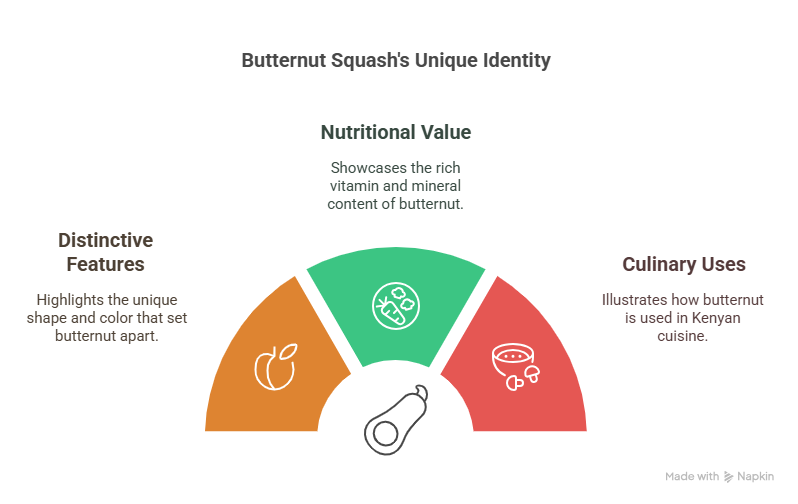
Getting Started: Varieties and Seeds
Top Butternut Varieties for Kenyan Farmers
Before you dig in, you need to know which variety to plant. Here are the stars of the Kenyan butternut scene:
| Variety | Maturity Period | Potential Yield | Special Features |
|---|---|---|---|
| Waltham | 90-100 days | 5-6 tonnes/acre | Classic variety, reliable |
| Atlas F1 | 90-100 days | 12-18 tonnes/acre | Fruits weigh 2-3kg each |
| Jupiter F1 | 90-100 days | High yield | Popular for flavor profile |
| Pluto F1 | 90-100 days | Good yield | Disease resistant |
For quality seeds, stick with reputable companies like Kenya Seed Company or Simlaw Seeds. You’ll find these at certified agro-vets in packages ranging from 10g to 500g, depending on your planting scale.
Land Preparation: Setting the Stage for Success
Soil Requirements That Make Butternuts Happy
Butternut thrives in well-draining, fertile soil with a pH between 6.0 and 6.8. Your best bet? Deep, fertile, well-drained loam soils with neutral pH. Before you plant, work some organic matter into the soil to boost its texture and fertility.
Prepping Your Land Like a Pro
Start by thoroughly plowing your land, then give it another go after 7-10 days. Next, harrow the field to break any hardpan and create a smooth surface for planting. The key move here is broadcasting compost manure evenly across your land—this supports those spreading vines and helps feeder roots soak up nutrients as the plant grows.
Planting Methods: Direct Sowing vs. Transplanting
You’ve got options when it comes to getting those seeds in the ground:
Direct Sowing: Plant 4-5 seeds on a small hill, about 3-5cm deep. Once they sprout, thin down to 2-3 seedlings. Give each hill about three feet of space all around – these vines like to spread out.
Transplanting: Start seeds indoors in small pots for 3-4 weeks before moving them outdoors. Wait until seedlings have 2-3 true leaves before transplanting. For hole preparation, dig 0.6-1 foot deep holes, spaced 1m by 1m apart. Mix 1 liter of slurry or 1kg of manure with soil in each hole a day before planting.
Growing Conditions and Care
Climate Requirements for Thriving Butternuts
Butternut squash loves temperatures between 18-30°C with annual rainfall between 700mm to 1000mm. In Kenya, aim to plant during April-June and August-December to align with rainfall patterns.
Water Management That Won’t Drown Your Profits
Water immediately after planting, then every 2-3 days until germination. Once established, keep the soil moderately moist but never waterlogged. Consistent moisture is crucial, but too much water leads to root diseases.
Weed Control That Works
Weeding should happen every 14 days up to 60 days after planting. Go for shallow hand weeding to avoid disturbing those crucial feeder roots. Keep the land level to let vines spread freely, maximizing sun exposure.
Fertilization: Feeding Your Future Harvest
At planting, apply 80kg of DAP or NPK 17-17-17 per acre. When vines reach 30cm in length, top dress with 100kg of CAN per acre. For organic enthusiasts, compost manure works wonders throughout the growth period. Consider foliar feeds to boost vine growth and leaf development.
Flowering, Pollination, and Fruit Development
The Critical Flowering Stage
After about 60 days, your plants will start flowering. During this delicate phase, ease up on weeding and top-dressing to avoid disturbing the flowers and developing fruits.
Pollination Tricks for Better Yields
Butternut requires cross-pollination for good fruit set. Since female flower parts sometimes emerge before male parts, try planting one line of butternut a week earlier or ensure there’s another butternut plantation nearby. This strategy increases your chances of successful pollination.
From Flower to Fruit
After successful pollination, small fruits begin to form and gradually increase in size. As fruits mature, the vine transitions from green to brown, while leaves may turn yellow. Ripe butternut develops that distinctive golden-yellow color after 90-100 days.
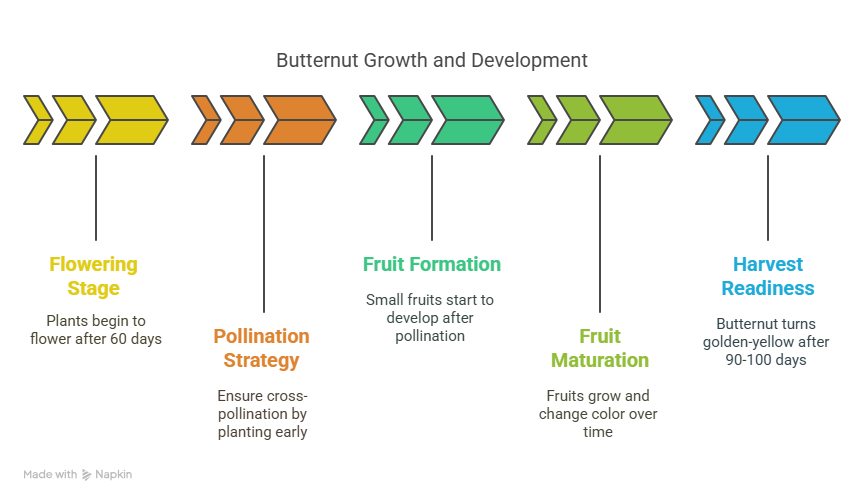
Pest and Disease Management
Common Threats to Your Butternut Crop
Keep an eye out for these troublemakers:
- Cutworms
- Squash bugs
- Aphids
- Squash vine borer
- Powdery mildew
- Anthracnose
Smart Control Strategies
For pest management, spray bio-pesticides 7 days after germination to control cutworms. Organic farmers can use neem and garlic extracts against powdery mildew, which loves cool weather.
If fruits develop black rot from fungal infection, remove and isolate them immediately to prevent spread. Continuous top-dressing with calcium-based bio-fertilizers strengthens plant resistance to diseases.
Harvesting, Storage, and Marketing
Knowing When and How to Harvest
Harvest time comes 85-90 days after planting, when fruits turn yellow and vines shift from green to brown. Harvest carefully by plucking the fruit along with a small portion of vine (5-10cm), which helps with curing and extends storage life.
Storage Secrets for Longer Shelf Life
After harvesting, let your butternuts cure in the sun for a couple of dry afternoons before storage. Keep them in cool, dry, well-ventilated areas. For optimal market value, store them for about a month before selling – this enhances flavor and texture.
Marketing Your Butternut Crop
The butternut market in Kenya continues to grow, with wholesale prices ranging from Ksh40 to Ksh70 per kilogram. Unlike pumpkins, which can be sold in slices, butternuts are typically sold whole, which affects your marketing approach.
Frequently Asked Questions
How much does it cost to start butternut farming in Kenya?
It costs approximately Ksh87,900 to grow one acre of butternuts in Kenya. This includes land preparation, seeds, fertilizers, pesticides, labor, and other inputs. With proper management, you can expect returns of about Ksh180,000, giving you a profit of around Ksh92,100 per acre.
Can I grow butternuts during the dry season?
Yes, but you’ll need irrigation. Butternuts require consistent moisture throughout their growing period. If you have access to reliable water sources for irrigation, you can grow butternuts year-round in Kenya.
How do I know if my butternut is ready to harvest?
Look for these signs:
- The skin has turned golden-yellow
- The vine has changed from green to brown
- Leaves are turning yellow
- The fruit has a hard rind that can’t be easily punctured with a fingernail
What’s the best way to store harvested butternuts?
After harvesting, cure your butternuts in the sun for 2-3 dry afternoons. Then store them in a cool, dry, well-ventilated place. Avoid stacking them too high or placing them directly on concrete floors. Proper storage can extend shelf life up to six months.
How many butternut plants can I grow per acre?
With spacing of 1m by 1m, you can grow approximately 4,000 plants per acre. However, depending on the variety and your specific growing conditions, you might adjust this spacing slightly.
Conclusion
Butternut farming in Kenya offers a promising opportunity for new farmers looking to diversify beyond traditional crops. With its relatively quick maturation period of 90-100 days, extended shelf life, and growing market demand, butternut squash can be a profitable addition to your agricultural portfolio.
Success requires attention to detail – from selecting the right variety to mastering proper harvesting techniques. But with the potential to earn over Ksh90,000 profit per acre in just three months, it’s worth the effort.
Ready to get your hands dirty with butternut farming? Start small, learn as you grow, and watch your golden harvest turn into golden profits.




